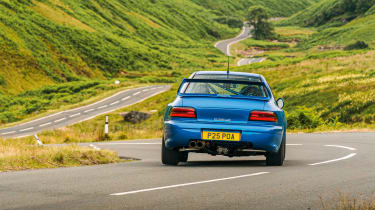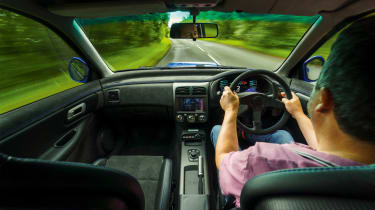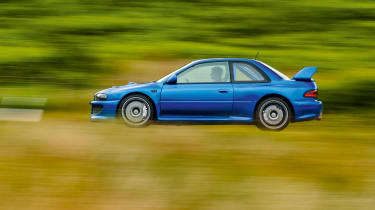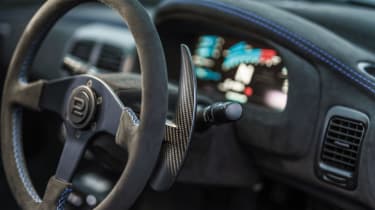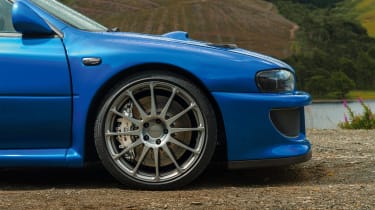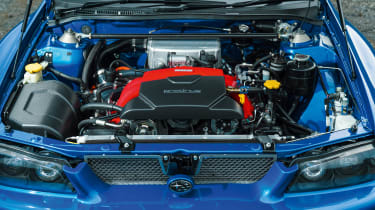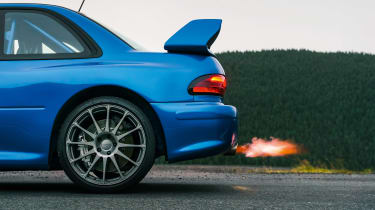Prodrive P25 review – this £552,000 Subaru Impreza is worth every penny
The P25 is Prodrive’s dazzling tribute to the iconic Subaru Impreza 22B STI. But can it possibly justify its eye-watering £552,000 price tag? There’s only one way to find out
So many years. So many memories. I’m not sure which marks the relentless passage of time more starkly: the fact that it’s 30 years since Prodrive’s blue and yellow 555-liveried Subaru Imprezas first gunned it down a WRC stage, or that it’s 15 years since the iconic partnership between Prodrive and Fuji Heavy Industries came to an end.
The Prodrive P25 marks another significant landmark. No, not evo’s 25th anniversary, but the introduction of the ultimate factory Impreza, the bubble-arched 22B STI. It’s a happy coincidence that the first issue of this magazine featured an exclusive UK first drive of the 22B. Yes, Subaru eventually shipped a batch of 16 Type UKs in 1999, but the early Japanese-spec model was a true unicorn. Securing the first (and at that time only) car in the country for our launch issue was a bit of a coup.
> Best Impreza Colin McRae Edition review – homage to McRae's championship 555 racer
If you’d told me then that a quarter of a century later I’d be driving a £552,000 Prodrive-built tribute to the 22B, I would have suggested you see a doctor. To be fair I’d have said the same thing about any of today’s restomod scene, and would likewise have raised an eyebrow at standard 22Bs selling at auction for well over £200k.
More reviews
Group tests
- Alpine A290 v Alpine A110 – how much DNA do they really share?
- Ariel Atom 4R v Caterham Seven ‘evo25’: power-to-weight heroes go head-to-head
- Aston Martin Vantage vs Audi R8 V10 RWD – back to basics
- Caterham Super Seven 600 v Super Seven 2000
- Levante v T1
- Corvette Stingray v Porsche Cayman GTS v Audi R8 RWD
- Great Ferrari hypercars driven: 288 GTO, F40, F50 and Enzo head-to-head
- Lamborghini Aventador Ultimae v Lamborghini Countach
- Lotus Emira v Morgan Plus Four – four-cylinder Brits go head-to-head
- Toyota GR86 v BBR Mazda MX-5: supercharged drop-top battles sports coupe
In-depth reviews
- Abarth 600e 2025 review – Italy gives the Alpine A290 something to worry about
- Alpine A110 review – distinctive, lightweight and unforgettable to drive
- Audi RS7 Sportback Performance review
- Bentley Continental R Mulliner: review, history and specs
- BMW 5-series review – is this still Munich’s anchor model?
- BMW 1-series review – Munich’s Audi A3 rival gains focus
Long term tests
- Abarth 695C Turismo Fast Fleet test – 10,000 miles in the Italian hot hatch
- Alfa Romeo Giulia Veloce Fast Fleet test – 7000 miles in the sharp Italian saloon
- Alpina B10: end of term report
- Alpina B10
- Ford Mustang GT
- Ford Mustang GT
- Ford Mustang GT
- Land Rover Defender 110 Fast Fleet test – 9000 miles in the go-anywhere SUV
- Maserati Ghibli Trofeo Fast Fleet test – 4000 miles in the Ferrari-powered saloon
- Mitsubishi Evo MR 340
Review
- New Aston Martin DBS 770 Ultimate review – 759bhp super-GT driven
- New Bentley Batur 2023 review – can it possibly be worth £1.65m?
- 2023 Chevrolet Corvette C8 Z06 review – the American 911 GT3?
- Kia EV6 GT-Line S prototype review – the EV that shows how it’s done
- BBR Supercharged Mazda MX-5 (ND) 2023 review – tuned 250bhp roadster driven
- MG4 Trophy 2023 review
Reviews
- Abarth 695 75 Anniversario edition 2024 review – a fitting send-off for Abarth’s hot supermini?
- Abarth 500e 2023 review
- AC Cobra 378 Superblower MkIV 2021 review – another V8 Cobra, but with a GM heart this time
- Acura Integra Type S 2024 review – a Honda Civic Type R with added restraint
- Alfa Romeo Giulia 2025 review – get one while you still can
- Alfa Romeo SZ: history, review and specs of an icon
- Alfa Romeo 1750 TBi
- Alpina B3 GT Touring 2025 review – a 190mph alternative to the BMW M3 Touring
It’s testament to the appeal and rarity of these late-’90s rally heroes that collectors are prepared to pay so much for cars that not so long ago could be found in the classifieds for £30k. On the flipside, if you’re someone who was never into these cars in period, the rise of the half-a-million-quid Impreza probably seems preposterous. Me? If I possessed the requisite moolah, I’d have one in a heartbeat. Spoiler alert: the P25 is so good it hurts.
It won’t convert non-believers – more likely it would confirm all their prejudices – but if you grew up with 2000 Turbos, WRXs, STIs, Spec Cs and 22Bs, the P25 is an ultimate fantasy. Outrageously exciting and madly addictive, it retains the spirit of its series-production forebears but surpasses all of them by a huge margin. Everything about it is sharper, more immediate and more intense. By borrowing DNA from the WRC cars but stopping short of being too uncouth and uncompromising for regular road use, it is the car anyone who ever hooned an Impreza imagined they were driving.
Imprezas and Mitsubishi Evos have always excelled when the tarmac gets gnarly, but the P25 truly revels in roads that would reduce carbon-tubbed exotica and certain track-honed rear-engined icons to a hot mess of swarf and splinters. Point-to-point, yump-to-yump, apex-to-exit, it’s an absolute monster.
Why is it so good? Well, the hardware’s very special, as we’ll see, but it’s the P25’s absolute authenticity that shines brightest and means the most. Nobody knows Imprezas better than Prodrive, so in all the ways that matter it’s more ‘factory’ than a car built by Subaru. With key technical staff from the Group A and WRC programmes still working at Prodrive’s Banbury HQ, you know the P25 benefits from the same brilliant brains and deft hands that led Subaru to a total of 46 WRC victories, a hat-trick of WRC manufacturers’ titles in 1995, 1996 and 1997, and a trio of drivers’ titles in ’95, ’01 and ’03.
David Lapworth – mastermind behind the build of the original Group A and WRC Imprezas – is leading the P25 programme. Mechanics and technicians who worked on Colin’s cars back in the day are also hands-on. Even Prodrive supremo David Richards has been directly involved, regularly driving the development car on his work commute to gauge progress and offer constructive criticism.
Typically, he hasn’t held back. Having driven home in darkness and been dismayed at the performance of standard Impreza lighting, Richards returned the next day and committed to the manufacture of new, fully E-Marked headlights and tail-lights. That’s a big investment for a run of 25 cars, but it’s evidence of Prodrive’s approach and, most pleasingly, signals that these cars have been created to be driven hard, on proper roads, in all weathers.
As you’d expect, the specification is straight from your wildest Gran Turismo dreams. Each P25 starts life as a two-door WRX STI. Then, in true restomod fashion, it is stripped to its bare bones until just the core body structure remains, whereupon it is restored to better-than-new condition. Most of the body panels are replaced by carbonfibre items, with only the original metal doors remaining for reasons of crash safety. Some of the panel gaps on this development car are a bit breezy, but we’re assured production P25s will boast uniform 4mm shutlines.
Peter Stevens – legendary designer and the man responsible for the look of the original two-door Impreza WRC97 – has had a hand in the design of the P25, adding another layer of credibility and continuity. It’s a stunning machine. More sinewy than the 22B, it sits brilliantly on forged 19-inch Prodrive-designed rims (some 2 inches bigger than the 22B’s), respectfully and refreshingly finished in silver-grey rather than default gold. Wrapped in 235/35 Bridgestone Potenza Sport tyres, it looks every inch the tarmac weapon.
If you’re familiar with Imprezas, or indeed any Japanese performance car from the ’90s and ’00s, you’ll be pleasantly surprised by the look, feel and execution of the P25’s interior. Handled by Callum (Ian Callum’s design and engineering consultancy) it feels suitably upgraded, with swathes of flawless double-stitched Alcantara upholstery and silky satin-finished carbon in place of the standard car’s exposed plastics. There’s even a decent hi-fi with integrated satnav and CarPlay. Despite the obvious improvements, it remains sympathetic to the simple, unpretentious style of the original car.
The undoubted highlight of the interior is the steering wheel and the large, crescent-shaped paddleshifter. The wheel really is an absolute delight. Devoid of switches and perfectly round (no awkward facets or squared-off bottom here) it feels perfect in your hands. The shifter is pure WRC, its fixed position and push-pull operation (push for downshifts, pull for upshifts) offering foolproof rally-style gearchanges.
That plain and simple steering wheel is indicative of an almost entirely analogue car. I can’t remember the last time I drove a new car with hydraulic power steering, let alone one also featuring passive, manually adjustable dampers, a non-synchromesh gearbox, no ESC or TC and stripped of servo assistance for the brakes. It sounds laughably low-tech and anachronistic, but if you’re fed up with toggling through myriad dynamic modes and generally ill at ease with the sometimes contrived and exaggerated responses these modes can deliver, the P25 is the antidote old-school purists such as myself have been yearning for. In a world where contemporary high-performance cars are defined by an increasingly digitised driving experience, it feels like coming home.
You could be forgiven for thinking such hardcore hardware must make the P25 a pig to drive, but it has manners. The six-speed dog ’box may not have any synchromesh, but the gears themselves are of helical design, not straight-cut. This brings a considerable improvement in refinement, with very little whine and chatter. There’s some lash at low speeds when you’re on and off the throttle, but you can mostly mitigate this with smooth inputs. The better you drive, the better it drives.
There are three pedals, but you only use the clutch for pulling away and when coming to a halt. The pedal is actually just a switch controlling the ‘by-wire’ clutch operation, so there’s very little feel and not much in the way of pedal effort. Getting a feel for the bite point has your tongue poking from the corner of your mouth with concentration, but an auto-release hill-hold function on the handbrake and clever anti-stall calibration of the clutch engagement means you quickly trust in the technology and stop overthinking things. The gearbox itself brings a razor-sharp edge to the driving experience. Pulling first gear at a standstill occasionally results in a kerchunk and a bell-like ring as the gear engages. It’s not as abrupt as it sounds, but it certainly puts you in the mood for the excitement to come. On the move, its shift speed is synaptic.
You have a choice of driving modes – Road, Sport and Sport+ – but they only serve to wind the engine up into an increasing degree of frenzy. According to Lapworth, the original plan was to run with ‘Stage’ instead of Sport, but that was deemed too provocative. Ironic given that you’re strapped into what is effectively a house-trained WRC car, complete with anti-lag and launch control.
We start in Road. The P25 is surprisingly mild-mannered and easy to manage as we work our way out of Hawick and head towards the sweeping, swooping roads that connect this Scottish Borders town with the forest roads of Kielder. Part-throttle gearshifts are smooth, the engine tractable at low revs. There’s even some pliancy to the suspension, just enough to take the sharpest edges off impacts with potholes and drain covers. It’s not exactly a pussycat, but it’s no headbanger either.
Historically, the main failing with quick Imprezas was their lack of steering weight and feel. It was hard to find a connection, so you had to trust that the grip and traction were there to lean on. Similarly, compared with the Mitsubishi Evo, Imprezas were more resolutely 50:50 in terms of their handling balance. Later cars with adjustable centre diffs offered a bit more throttle steerability, but they never had the inherent agility of the livewire Lancer.
No such issues with the P25. In fact, it’s a revelation. The steering has superb weight and feel, with the bonus of a perfectly linear rate of response. The resulting bond is immediate, your sense of where the front wheels are pointing and how much grip they have available unrelentingly consistent and completely instinctive. For someone who has spent years railing against overly sharp steering and EPAS that attempts to pass off effort as feel, the way the P25 points into corners is sublime.
There’s still much to learn about its handling. The nose is absolutely nailed to the tarmac, but the rear feels unusually keen to rotate. It’s slightly unnerving, in much the same way that an aggressively set-up front-wheel-drive car can be, but give yourself time to gain confidence and gradually you begin to understand what’s going on beneath you.
The sense of rotation comes from the rear end’s compliance, the split-second ‘loose’ feeling traced to the action of the active centre diff and the moment when the rear settles into its permitted degree of roll before transferring that load into the road and finding extraordinary traction. In this regard it’s unlike anything else I’ve ever driven.
Later, when I mention it to Lapworth, he provides the perfect lightbulb moment, describing how the P25 was set up to suit the rally driver’s preference for a car to always feel capable of making a direction change. This contrasts with a circuit racing mentality, in which the driver wants turn-in combined with a greater feeling of stability and neutrality.
The P25 has been set up by three-time British Rally Champion Mark Higgins – he of the hair-raising Isle of Man car lap record in a Time Attack WRX‑STI and countless stunt driving sequences in the last four James Bond movies. True to Lapworth’s description, Higgins has got the P25 up on the balls of its feet, ready to jink and dart and react to the driver’s inputs, but with immense underlying grip and predictability.
Some of this is down to a new front suspension design, which changes the pick-up points to closely mimic WRC Impreza geometry, plus trick Bilstein dampers with internals tuned to meet Prodrive-specific force and velocity curves. It’s also heavily influenced by the active centre diff, which is controlled to aid stability under braking and help rotate the car in the initial turn-in phase before maximising cross-axle traction when you chase the throttle. It’s not just different to any Impreza I’ve driven, but quite unlike any truly fast car I’ve ever experienced. If you enjoy the cerebral side of exploring a car’s dynamics, the P25 a fascinating car to get to know.
Though much of the P25 is a lesson in analogue engineering, certain areas of the car are very much part of the digital age. Specifically, the powertrain management, which is controlled by Bosch Motorsport electronics using code taken directly from Prodrive���s WRC, Rally Raid and GT racing programmes. There’s an onerous amount of validation required to get this motorsport-grade management system homologated for road use, but it offers far more scope and allows Prodrive to leverage learnings gained from competing at the highest levels of international motorsport.
The engine, meanwhile, is a force of nature. It’s based on the EJ25 2.5-litre found in the nose of the 2018 STI, Prodrive buying fresh crate engines from Subaru before rebuilding them in-house with forged pistons, steel con rods, ported cylinder heads and new cams, plus a new turbocharger, inlet and exhaust manifolds, baffled sump, and fuel and cooling systems.
The results are hugely impressive, with a solid 440bhp at 6000rpm and 457lb ft from just 3000rpm. Combined with an admirable 1180kg kerb weight, there’s explosive in-gear punch and a scintillating lack of inertia that today’s more powerful but significantly heavier contemporary cars simply can’t match. If you’re a fan of the early McRae-era Impreza soundtrack, then the P25’s lack of off-beat rasp might disappoint (equal-length inlet manifolds are to blame, apparently), but the sharp rasp is so redolent of later Subaru WRC cars that you half expect to hear the shrill blast of marshals’ whistles as it approaches.
Firing the P25 from a standstill in full Launch Control mode is absolutely outrageous, savage pops and bangs punctuated by shots of flame from the Akrapovic exhaust in the moments before the pin is pulled and you explode off the line. Anti-lag pumps raw, dirty decibels from the exhaust and feels arrest-me-now naughty. It sharpens on/off throttle response, too, but not to the extent it used to back in the day thanks to modern engine management that keeps the turbo spinning at meaningful rpm without the need for additional fuelling or holding boost pressure.
How quick? Well, on a damp road and cold tyres the P25 hit 60mph in 3.2sec, which suggests the 2.8sec run recorded during testing in ideal conditions was far from a one-off. I’m not sure what’s more exciting: being in the car as it does it or witnessing the action from outside, when it goes from here to waaaay over there in a few blinks of the eye and a handful of gunshot upshifts. Top speed is limited to 150mph, but point-to-point pace is on another level: in testing, the P25 comfortably outpaced a 991 GT3 RS around Millbrook’s rollercoaster Alpine Route. Frankly I’m not surprised.
What haven’t we talked about? The brakes. Massive AP Racing discs and calipers sit barely contained behind the thin-spoked alloys. They don’t have servo assistance, so need more pedal effort than you’re used to, but they offer much more than the solid, wooden-feeling pedal you might expect. Once you understand they need a more insistent squeeze, you will marvel at the stopping power and exceptional feel.
Encouraged to test them from high speed, I accelerate to, um, considerable velocity before hitting the middle pedal as I would in a race car. The result is eye-popping, but it’s the precision with which you can modulate the brakes that leaves the greater impression. Such is the level of feedback, you can work the brakes to the point where you can feel the tyres’ tread blocks squirming in discomfort but not overwork them to the point of locking. I’d be tempted to left-foot brake, but memories of stuffing an Evo VI RS Sprint into a hedge attempting to do just that provide a timely sense check. Uncannily exploitable though it is, it’s wise not to confuse the P25’s towering limits with your own.
In case you’re in any doubt, this car is something truly remarkable. That it would have a scintillating turn of speed was a given. What makes it so bewitching is the fact that it generates this pace without relying on a suite of sophisticated electronic aids and delivers it in a way that’s rewarding at any speed. This is driving at its most compelling.
£552,000 is an immense asking price for any car. And especially one that famously made its name as an affordable performance icon. However, this irony hasn’t proved a barrier to purchase, with all 25 build slots taken and six cars already well on their way to completion. If only I’d worked harder at school…
Prodrive has worked wonders to ensure you don’t have to be a WRC champion to get the best from the P25. Crucially just as much effort was put into making sure you feel like a WRC champion whenever you drop into its driver’s seat. Flat over crest maybe.
Prodrive P25 specs
| Engine | Flat-four, 2457cc, turbocharged |
| Power | 440bhp @ 6000rpm |
| Torque | 457lb ft @ 3000rpm |
| Weight | 1180kg |
| Power-to-weight | 379bhp/ton |
| 0-62mph | 2.8sec |
| Top speed | 150mph (limited) |
| Basic price | £552,000 |
This story was first featured in evo issue 313.
